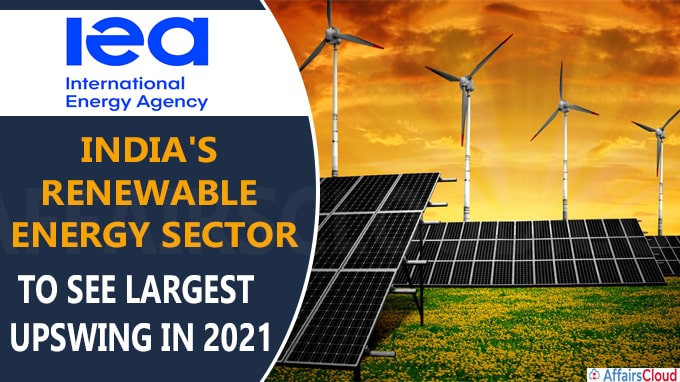
According to the International Energy Agency’s (IEA) report, Renewables 2020 – Analysis and Forecast to 2025, India’s Renewable Energy sector will see the largest growth after COVID-19. India will double its green energy capacity addition in 2021 compared to 2020 levels.
Driven by China and the United States, new additions of renewable power capacity worldwide are expected to a record level of almost 200 Gigawatts (GW) in 2020.
Highlights of the report:
i.The report has predicted a decline in Global renewable capacity addition in 2022 due to expiry of incentives and policy uncertainties.
ii.The Renewable capacity additions are on track for a record expansion of nearly 10% in 2021.
iii.Total Installed Wind and Solar PV capacity will surpass natural gas in 2023 and coal in 2024. Solar PV accounts for 60% of all renewable capacity additions through 2025, and wind provides another 30%.
iv.Renewable will overtake coal to become the largest source of electricity generation worldwide in 2025 (one-third of world’s electricity supply). Hydropower will be the largest source of renewable electricity worldwide, followed by wind and solar PV.
v.Global transport biofuel production in 2020 is expected to decline by 12%, which is the first reduction in annual production in two decades.
Key Points about India:
India has auctioned 8.2 GW of new PV capacity by September, 2020 despite the disruptions caused by COVID-19.
India’s wind and solar market
i.India’s wind capacity additions are expected to drop 60 % in 2020 compared to 2019 (Fall of 1 Gigawatt).
ii.India’s solar PV (Photovoltaic) capacity additions are projected to be a third lower in 2020 than in 2019.
iii.As the delayed and new projects will become operational post COVID-19, a rebound in PV deployment is expected for 2021 & 2022 with capacity additions exceeding the 2019 levels.
Distribution Utility Woes:
i.Financial instability due to COVID-19 has led to Distribution utility woes in India.
ii.The report highlights that New renewable energy plants managed by utilities with low credit rating will face greater obstacles than those managed by healthier utilities.
iii.From January to June 2020, total overdue payments owed by utilities rose 28% for all electricity Generators and 10 % for renewable electricity plants.
iv.Government of India’s Ujjwal DISCOM (Distribution Companies of India) Assurance Yojana (UDAY) which was introduced in 2015 to improve the financial health of utilities has only been partially successful.
Innovations
i.Innovations such as wind-solar-storage hybrid auctions have made renewables more competitive.
ii.The report also highlighted that the issues of transmission grid bottlenecks and land acquisition are being addressed through Green Energy Corridor and Solar Parks.
Recent Related News:
i.On January 10,2020 the International Energy Agency (IEA) in partnership with NITI Aayog has released the first in-depth review of India’s energy policies 2020 in New Delhi.
ii.May 7, 2020, In accordance with the International Energy Agency (IEA), “Global Energy Review 2020-The impacts of the COVID-19 crisis on global energy demand and CO2 emissions” India’s energy demand has faced a 30% decrease due to 40 days’ lockdown to contain COVID-19.
About International Energy Agency:
Executive Director – Dr Fatih Birol
Headquarters – Paris, France